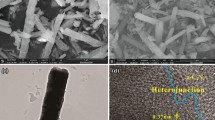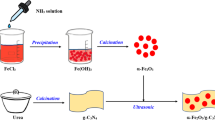Abstract
In this investigation, phosphotungstic acid (H3PW12O40) was successfully self-assembly implanted into the interspace of K4Nb6O17 nanosheet via an impregnation method to form an adsorption-photocatalytic composite, in which n-type semiconductor K4Nb6O17 was selected as photo-electron emitter and H3PW12O40 was particularly used as an electronic transmitter. By characterizing with X-ray diffraction (XRD), transmission (TEM), scan electron microscopy (SEM), X-ray photoelectron spectroscopy (XPS), and FT-IR spectrum (FT-IR), it confirmed that H3PW12O40 (HPW) was converted to the insoluble tiny particles of K3PW12O40 (KPW) with the remained primary Keggin group via an ion-exchanged H+ of HPW with K+ in K4Nb6O17 in the implanted process and was firmly bound to the surface of K4Nb6O17 to form well sandwich structure. UV-vis diffuse reflectance spectroscopy revealed that the band gap of K4Nb6O17-K3PW12O40 have a slight red shift compared with the single K4Nb6O17. Its adsorption-photocatalytic properties were evaluated with the removal of tetracycline as model reaction. Compared with pure K4Nb6O17, tetracycline removal rate can be significantly improved for the as-prepared sandwich. Importantly, the removal could still maintain 70% after five reuses in recycle tests at an acidic solution, inferring a good stability which was mainly ascribed to the formation of water-insoluble K3PW12O40. The separation and transfer process of photogenerated electrons were investigated by surface photovoltage spectroscopy (SPV). It proposed that the KPW anchored firmly on the interlayers of K4Nb6O17 through a O-K-O bridge plays a significantly role in promoting the separation of the photogenerated carriers and preventing the leakage and agglomeration of HPW. The present results showed that the strategy of the phosphotungstic acid binding in situ to K4Nb6O17 was favorable to promote the hetero-photocatalytic efficiency as well as reusability.

Mechanism for tetracycline photodegradation over the K4Nb6O17-KPW photocatalytic system
















Similar content being viewed by others
References
Bound JP, Voulvoulis N (2004) Pharmaceuticals in the aquatic environment—a comparison of risk assessment strategies. Chemosphere 56:1143–1155
Chao Y, Zhu W, Ye Z, Wu P, Wei N, Wu X, Li H (2015) Preparation of metal ions impregnated polystyrene resins for adsorption of antibiotics contaminants in aquatic environment. J Appl Polym Sci 132
Chen C, Wang Q, Lei P, Song W, Ma W, Zhao J (2006) Photodegradation of dye pollutants catalyzed by porous K3PW12O40 under visible irradiation. Environ Sci Technol 40:3965–3970
Cui W, Wang H, Liang Y, Han B, Li L, Hu J (2013) Microwave-assisted synthesis of Ag@AgBr-intercalated K4Nb6O17 composite and enhanced photocatalytic degradation of Rhodamine B under visible light. Chem Eng J 230:10–18
Deng QL, Li MJ, Wang JY, Zhang P, Jiang K, Zhang JZ, Hu ZG, Chu JH (2017) Exploring optoelectronic properties and mechanisms of layered ferroelectric K4Nb6O17 nanocrystalline films and nanolaminas. Sci Rep 7
Essayem N, Holmqvist A, Gayraud PY, Vedrine JC, Taarit YB (2001) In situ FTIR studies of the protonic sites of H3PW12O40 and its acidic cesium salts MxH3−xPW12O40. J Catal 197:273–280
Furube A, Shiozawa T, Ishikawa A, Wada A, Hirose C, Domen K (2002) Primary process of photogenerated carriers in ion-exchanged K4Nb6O17 thin films investigated by femtosecond transient absorption spectroscopy. Chem Phys 285:31–37
Garwood WE, Venuto PB (1968) Paraffin-olefin alkylation over a crystalline aluminosilicate. J Catal 11:175–177
Gasperin M, Bihan MTL (1982) Mecanisme d'hydratation des niobates alcalins lamellaires de formule A4Nb4O17 ( A = K, Rb, Cs). J Solid State Chem 43:346–353
Guo X, Hou W, Bao G, Yan Q (2006) Synthesis and characterization of porous chromia-pillared layered lanthanum niobic acid. Solid State Ionics 177:1293–1297
Hashemikia S, Hemmatinejad N, Ahmadi E, Montazer M (2015) Optimization of tetracycline hydrochloride adsorption on amino modified SBA-15 using response surface methodology. J Colloid Interface Sci 443:105–114
He D, Sun Y, Xin L, Feng J (2014) Aqueous tetracycline degradation by non-thermal plasma combined with nano-TiO2. Chem Eng J 258:18–25
Hernández Enríquez JM, Alamilla RG, García UP, Rodrigo RS (2013) SÍNTESIS QUÍMICA, ESTUDIOS DE CARACTERIZACIÓN Y REACTIVIDAD DE UN MATERIAL CATALÍTICO A BASE DE ZrO2-H3PW12O40. Quim Nova 36:937–941
Hirsch R, Ternes T, Haberer K, Kratz KL (1999) Occurrence of antibiotics in the aquatic environment. Sci Total Environ 225:109–118
Izumi Y, Urabe K, (1981) Catalysis of heteropoly acids entrapped in activated carbon, Chem Lett 663–666
Jehng JM, Wachs IE, (2010) ChemInform abstract: structural chemistry and Raman spectra of niobium oxides, ChemInform 22
Jing L, Sun X, Shang J, Cai W, Xu Z, Du Y, Fu H (2003) Review of surface photovoltage spectra of nano-sized semiconductor and its applications in heterogeneous photocatalysis. Sol Energy Mater Sol Cells 79:133–151
Kümmerer K (2001) Drugs in the environment: emission of drugs, diagnostic aids and disinfectants into wastewater by hospitals in relation to other sources-a review. Chemosphere 45:957–969
Lee KY, Mizuno N, Okuhara T, Misono M (2006) Catalysis by heteropoly compounds. XIII. An infrared study of ethanol and diethyl ether in the pseudoliquid phase of 12-tungstophosphoric acid. B Chem Soc Jpn 62:1731–1739
Li K, Guo Y, Ma F, Li H, Chen L, Guo Y (2010) Design of ordered mesoporous H3PW12O40-titania materials and their photocatalytic activity to dye methyl orange degradation. Catal Commun 11:839–843
Li FT, Wang Q, Wang XJ, Li B, Hao YJ, Liu RH, Zhao DS (2014) In-situ one-step synthesis of novel BiOCl/Bi24O31Cl10 heterojunctions via self-combustion of ionic liquid with enhanced visible-light photocatalytic activities. Appl Catal B Environ 150-151:574–584
Liang Y, Shao M, Liu L, Mcevoy JG, Hu J, Cui W (2014) Synthesis of Cu2S/K4Nb6O17 composite and its photocatalytic activity for hydrogen production. Catal Commun 46:128–132
Lin HY, Lee TH, Sie CY (2008) Photocatalytic hydrogen production with nickel oxide intercalated K4Nb6O17 under visible light irradiation. Int J Hydrogen Energy 33:4055–4063
Liu ZS, Ran HS, Niu JN, Feng PZ, Zhu YB (2014) One-pot synthesis of bismuth Oxyhalide/Oxygen-rich bismuth oxyhalide Heterojunction and its photocatalytic activity. J Colloid Interface Sci 431:187–193
Long DL, Burkholder E, Cronin L (2007) Polyoxometalate clusters, nanostructures and materials: from self assembly to designer materials and devices. ChemInform 36:105–121
Lu N, Lu Y, Liu F, Zhao K, Yuan X, Zhao Y, Li Y, Qin H, Zhu J (2013) H3PW12O40/TiO2 catalyst-induced photodegradation of bisphenol A (BPA): kinetics, toxicity and degradation pathways. Chemosphere 91:1266–1272
Ma J, Wu J, Gu J, Liu L, Zhang D, Xu X, Yang X, Tong Z (2012) Fabrication and spectroscopic, electrochemical, and catalytic properties of a new intercalation compound of K4Nb6O17 with cationic cobalt porphyrin. J Mol Catal A Chem 357:95–100
Ma Y, Liu X, Li Y, Su Y, Chai Z, Wang X (2014) K4Nb6O17·4.5H2O: a novel dual functional material with quick photoreduction of Cr(VI) and high adsorptive capacity of Cr(III). J Hazard Mater 279:537–545
Maeda K, Eguchi M, Youngblood WJ, Mallouk TE (2008) Niobium oxide nanoscrolls as building blocks for dye-sensitized hydrogen production from water under visible light irradiation. Chem Mater 20:6770–6778
Roess AA, Winch PJ, Akhter A, Afroz D, Ali NA, Shah R, Begum N, Seraji HR, El AS, Darmstadt GL (2015) Household animal and human medicine use and animal husbandry practices in rural Bangladesh: risk factors for emerging zoonotic disease and antibiotic resistance. Zoonoses Public Health 62:569–578
Rooklidge SJ (2004) Environmental antimicrobial contamination from terraccumulation and diffuse pollution pathways. Sci Total Environ 325:1–13
Safari GH, Hoseini M, Seyedsalehi M, Kamani H, Jaafari J, Mahvi AH (2015) Photocatalytic degradation of tetracycline using nanosized titanium dioxide in aqueous solution. Int J Environ Sci Technol 12:603–616
Sarmah AK, Meyer MT, Boxall AB (2006) A global perspective on the use, sales, exposure pathways, occurrence, fate and effects of veterinary antibiotics (VAs) in the environment. Chemosphere 65:725–759
Schwegler MA, Bekkum HV, Munck NAD, (1991) Heteropolyacids as catalysts for the production of phthalate diesters, Appl Catal 191–204
Sivakumar R, Thomas J, Yoon M (2012) Polyoxometalate-based molecular/nano composites: advances in environmental remediation by photocatalysis and biomimetic approaches to solar energy conversion. J Photochem Photobiol C Photochem Rev 13:277–298
Su F, Wu Q, Song D, Zhang X, Wang M, Guo Y (2013) Pore morphology-controlled preparation of ZrO2-based hybrid catalysts functionalized by both organosilica moieties and Keggin-type heteropoly acid for the synthesis of levulinate esters. J Mater Chem A 1:13209–13221
Sun M, Zhao Q, Du C, Liu Z (2015) Enhanced visible light photocatalytic activity in BiOCl/SnO2: heterojunction of two wide band-gap semiconductors. RSC Adv 5:22740–22752
Tao H, Yao J (2006) Photochromism in composite and hybrid materials based on transition-metal oxides and polyoxometalates. Prog Mater Sci 51:810–879
Thomas J, Radhika S, Yoon M (2016) Nd3+-doped TiO2 nanoparticles incorporated with heteropoly phosphotungstic acid: a novel solar photocatalyst for degradation of 4-chlorophenol in water. J Mol Catal A Chem 411:146–156
Wang D, Lu S, Xiang Y, Jiang SP (2011) Self-assembly of HPW on Pt/C nanoparticles with enhanced electrocatalysis activity for fuel cell applications. Appl Catal B Environ 103:311–317
Wang Y, Kecheng LU, Feng C (2013) Influence of inorganic anions and organic additives on photocatalytic degradation of methyl orange with supported polyoxometalates as photocatalyst. J Rare Earth 31:360–365
Weinstock IA (1998) Homogeneous-phase electron-transfer reactions of polyoxometalates. Chem Rev 98:113–170
Wu HH, Xie HR, He GP, Guan YF, Zhang YL (2015) Effects of the pH and anions on the adsorption of tetracycline on iron-montmorillonite. Appl Clay Sci 119:161–169
Xing W, Ni L, Liu X, Luo Y, Lu Z, Yan Y, Huo P (2015) Effect of metal ion (Zn2+, Bi3+, Cr3+, and Ni2+)-doped CdS/halloysite nanotubes (HNTs) photocatalyst for the degradation of tetracycline under visible light. Desalin Water Treat 53:794–805
Xu H, Li HM, Xu L, Wu CD, Sun GS, Xu YG, Chu JY (2009a) Enhanced photocatalytic activity of Ag3VO4 loaded with rare-earth elements under visible-light irradiation. Ind Eng Chem Res 48:10771–10778
Xu LL, Wang YH, Xia Y, Hu JL, Wei L, Guo YH (2009b) Simultaneous esterification and transesterification of soybean oil with methanol catalyzed by mesoporous Ta2O5/SiO2-H3PW12O40/R (R = Me or Ph) hybrid catalysts. Green Chem 11:314–317
Xu Y, Wang X, Wei G, Wu MM, Yan Y, Bo H, Che G, Han D, Yang J, Fan W (2015) Single-crystalline AgIn(MoO4)2 nanosheets grafted Ag/AgBr composites with enhanced plasmonic photocatalytic activity for degradation of tetracycline under visible light. Appl Catal B Environ 164:297–304
Yoon M, Chang JA, Yanghee Kim A, Choi JR, And KK, Lee SJ (2001) Heteropoly acid-incorporated TiO2 colloids as novel photocatalytic systems resembling the photosynthetic reaction center. J Phys Chem B 105:2539–2545
Zhang J, Giorno L, Drioli E (2006) Study of a hybrid process combining PACs and membrane operations for antibiotic wastewater treatment. Desalination 194:101–107
Zhang X, Li S, Liu C, Feng D, Zhang T, Tong Z, Inoue H (2009) Characterization of photoelectrochemical active intercalation compound of K4Nb6O17 with methylviologen. Microporous Mesoporous Mater 117:326–330
Zhang J, Chuang LI, Wang B, Cui H, Zhai JP, Qin LI (2013) Synthesis, characterization and photocatalytic application of H3PW12O40/BiVO4 composite photocatalyst. Sci China Chem 56:1285–1292
Zhang J, Wang A, Wang Y, Wang H, Gui J (2014a) Heterogeneous oxidative desulfurization of diesel oil by hydrogen peroxide: catalysis of an amphipathic hybrid material supported on SiO2. Chem Eng J 245:65–70
Zhang T, Wang M, Yang W, Yang Z, Wang Y, Gu Z (2014b) Synergistic removal of copper(II) and tetracycline from water using an environmentally friendly chitosan-based flocculant. Ind Eng Chem Res 53:14913–14920
Zhong T, Tang JL, Zhu MK, Hou YD, Wang H, Yan H (2005) Synthesis and characterization of layered niobate K4Nb6O17 thin films by niobium-chelated precursor. J Cryst Growth 285:201–207
Acknowledgments
This work is financially supported by National Natural Science Foundation of China (Grants 21777078 and 21567017), the open project of the state key laboratory of inorganic synthesis and preparative chemistry of Jilin University (2016-10), and the Project of Research and Development of the Applied Technology for Inner Mongolia 2016.
Author information
Authors and Affiliations
Corresponding author
Ethics declarations
Conflict of interest
The authors declare no conflict of interest.
Electronic supplementary material
ESM 1
(DOCX 697 kb)
Rights and permissions
About this article
Cite this article
Gu, H., Lang, J., Ma, Y. et al. Phosphotungstic acid binding in situ to K4Nb6O17 for the effective adsorption-photocatalytic removal of tetracycline. J Nanopart Res 20, 132 (2018). https://doi.org/10.1007/s11051-018-4229-z
Received:
Accepted:
Published:
DOI: https://doi.org/10.1007/s11051-018-4229-z




